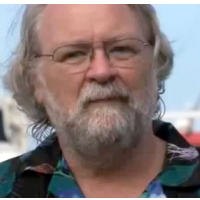Entrepreneur “Seeds” Ocean with 100 Tons of Iron Dust, Outrages Scientists
 Russ George (photo: VPROBeagle)
Russ George (photo: VPROBeagle)
Russ George was anointed the world’s first geo-vigilante in The New Yorker this week for dumping 100 tons of iron sulfate off the coast of British Columbia in July, triggering a 10,000-square-kilometer plankton bloom that the California businessman hoped would pull carbon dioxide from the atmosphere and take to the Pacific Ocean’s depths.
George’s plan is to use geoengineering to heal the planet and fight global warming, while creating lucrative carbon credits to trade in burgeoning international markets.
A Montreal watchdog, etc Group, revealed George’s ocean seeding earlier in the month and The Guardian gave it its first publicity, while noting an uproar from “lawyers, environmentalists and civil society groups.” They called it a violation of at least two international laws.
George told The Guardian that his team of scientists had collected a mother lode of data and, without revealing any of it, assured them that the experiment had been a success. “We've gathered data targeting all the possible fears that have been raised [about ocean fertilization],” George said. “And the news is good news, all around, for the planet.”
George is the chief scientist for the Haida Salmon Restoration Corporation’ (HSRC), a corporation created at George’s behest by the leaders of an indigenous village on one of the Haida Gwaii islands (a.k.a. Queen Charlotte Islands), 200 nautical miles from where he left his mark. The village was promised large returns on its investment. They gave him $1 million.
George used to run a company in Foster City called Planktos Inc.—now defunct, but succeeded by Planktos Science—which was rebuffed while pursuing similar seedings near the Galapagos Islands and the Canary Islands. The Spanish and Ecuadorian governments banned him from their ports and the U.S. Environmental Protection Agency warned him against flying the U.S. flag during his activities.
Some have credited the attention George received from his earlier attempts for a United Nations moratorium on ocean fertilization experiments.
Iron fertilization, the science that George is promoting, is part of a larger debate over the wisdom of trying to affect massive, quick ecosystem changes on a global scale. They include geoengineering techniques like shooting large amounts of material into the atmosphere to reflect sunlight away from the Earth.
Iron fertilization is also part of a smaller debate over whether it does more harm than its questionable good. Scientists believe that the bloom of plankton is accompanied by a bloom in bacteria as the plankton die. That bacteria could contribute to producing nitrous oxide, a greenhouse gas, and help alter the chemistry of the ocean itself. The science is still early and sketchy.
–Ken Broder
To Learn More:
A Rogue Climate Experiment Outrages Scientists (by Henry Fountain, New York Times)
Entrepreneur Got Away With Dumping 100 Tons of Iron Dust in Ocean (by Sydney Brownstone, Mother Jones)
World's Biggest Geoengineering Experiment “Violates” UN Rules (by Martin Lukacs, The Guardian)
World’s Largest Geoengineering Deployment off Coast of Canada’s British Columbia (etc Group)
Planktos Kills Iron Fertilization Project Due to Environmental Opposition (MongaBay Environmental News)
- Top Stories
- Controversies
- Where is the Money Going?
- California and the Nation
- Appointments and Resignations
- Unusual News
- Latest News
- California Forbids U.S. Immigration Agents from Pretending to be Police
- California Lawmakers Urged to Strip “Self-Dealing” Tax Board of Its Duties
- Big Oil’s Grip on California
- Santa Cruz Police See Homeland Security Betrayal in Use of Gang Roundup as Cover for Immigration Raid
- Oil Companies Face Deadline to Stop Polluting California Groundwater





